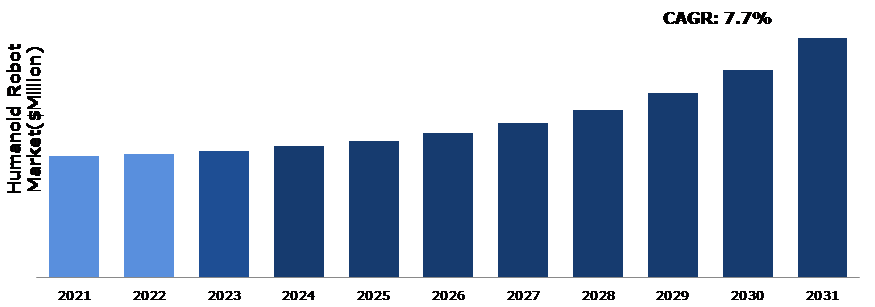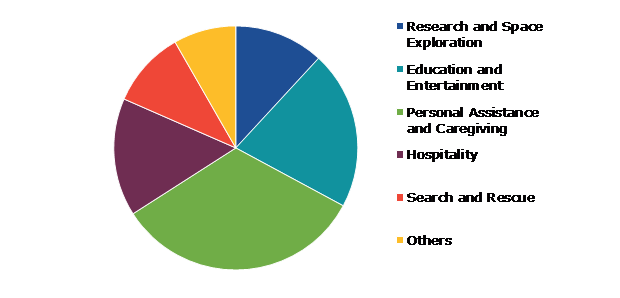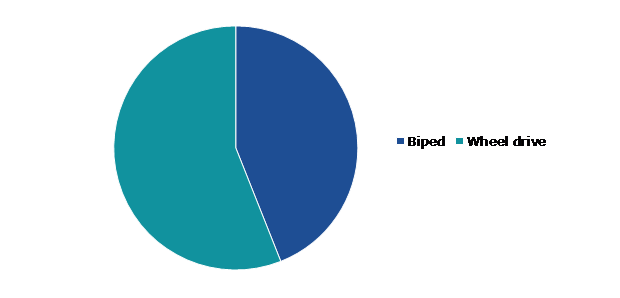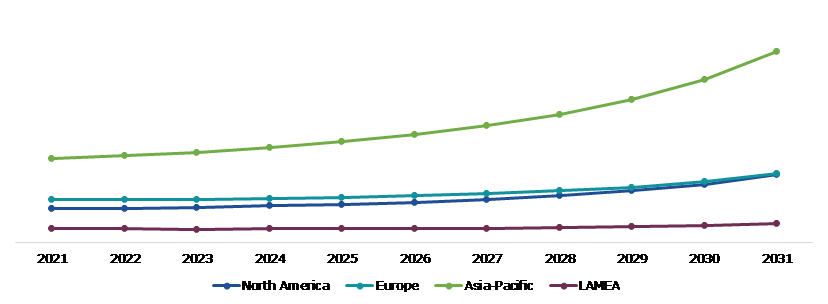Humanoid Robot Market Report
RA00110
Humanoid Robot Market by Component (Hardware and Software), Application (Research & Space Exploration, Education & Entertainment, Personal Assistance & Caregiving, Hospitality, Search & Rescue, and Others), Motion Type (Biped and Wheel Drive), and Region (North America, Europe, Asia-Pacific, and LAMEA): Global Opportunity Analysis and Industry Forecast 2022–2031
Update Available On-Demand
Global Humanoid Robot Market Analysis
The Global Humanoid Robot Market Size was $307.6 million in 2021 and is predicted to grow with a CAGR of 7.7%, by generating a revenue of $609.5 million by 2031.
Global Humanoid Robot Market Synopsis
A humanoid robot is a professional service robot that not only resembles human physical characteristics, such as one head, a torso, two arms, and two legs, as well as a face, eyes, and mouth, but also has the ability to communicate with humans and other robots, interpret information, and perform specific tasks based on the user's input. It is totally automated since it can adapt to its environment and continue to achieve its aims. The growth of the humanoid robot market is primarily being driven by the expanding use of humanoid robots in security and surveillance applications, such as the detection of unauthorized intrusion, terrorist activities, and improved use of AI robots in dangerous environments, as well as research and space exploration that allows connectivity from a distance. Furthermore, rapid development of advanced robots to improve customer interaction and experience, as well as rising demand for robots in retail applications, are some of the other market drivers for humanoid robots. These factors are anticipated to boost the humanoid robot market growth in the upcoming years.
Significant barriers to the growth of the humanoid robot market include the high initial cost of the robots and the significant investments necessary for R&D activities. The lack of advanced infrastructure necessary for the design and production of humanoid robots is also anticipated to have an effect on the humanoid robot market size.
In commercial or retail sector, humanoid robots are used to serve customers, demonstrate product features, and assist in efficiently collecting customer information like phone numbers, zip codes, email addresses, and service feedback. Government investments in R&D and the use of humanoid robots in education can help to transform inefficient infrastructure and drive the humanoid robot market growth. As the technology continues to grow, there may be even more opportunities for innovation and expansion in upcoming year. Nevertheless, the introduction of new components in humanoid robots has the potential to revolutionize the market and offer exciting new opportunities for innovation and growth. As technology continues to evolve, it will be interesting to see what new capabilities and applications will emerge for these fascinating machines. Important market players are interacting with their clients to comprehend needs and create effective solutions. Advanced humanoid robots are used by NASA and other space organizations to conduct space research on extraterrestrial planets for a variety of purposes, such as taking close-up photos of planets and figuring out whether or not they can support life. All these factors are predicted to create excellent opportunities for market growth.
Humanoid Robot Overview
Humanoid robots have human-like characteristics and resemble humans in both appearance and behavior. Humanoid robots have advantages such as safe load carrying, high efficiency, high precision, and the ability to carry out tasks in less time. Humanoid robots can be utilized for a variety of practical reasons, including interacting with humans, conducting experiments, automating industrial processes, and so on. Female humanoid robots are known as gynoids, whereas male humanoid robots are classified as androids.
COVID-19 Impact on Global Humanoid Robot Market
The COVID-19 impact on humanoid robot market pandemic hampered the expansion of the market in the first half of 2020. The rapid spread of the virus prevented the export of humanoid robot components, affecting humanoid robot manufacturing during the first two quarters of 2020. During the crisis, the primary goal of market participants was to sustain their businesses by finding safer ways to continue manufacturing operations or other sustainable ways to keep the revenue stream flowing. However, demand for humanoid robots increased in the medical sector in the latter half of 2020. They were used in hospitals to ensure the safety of medical personnel as well as to provide food and medicine to patients infected with the virus. Robots were used in healthcare and other sectors to limit human interaction during the pandemic. Furthermore, humanoid robot assistants are used in a variety of applications, including sanitizer distribution, food materials and packets, thermal scanning, and others. for example, UVD Robots is a Danish business that has created disinfection robots for operating and inpatient rooms. They sterilize nearly everything; each robot is a portable array of strong short-wavelength ultraviolet-C (UVC) light sources that emit energy that harms the DNA or RNA of bacteria that come into touch with them.
Rising Demands for Advanced Robots and Increased Demand from the Retail Sector to Drive the Market Growth
The fast development of advanced robots to increase customer interaction and experience, as well as the rising demand for robots in retail applications are important drivers of the humanoid robot industry. Furthermore, the market expansion is anticipated to be fueled by the rising demand for humanoid robots to provide personal help in daily life. In addition, as public awareness of technological developments in humanoid robots grows, manufacturing companies are increasingly accepting these robots to save labor costs and increase yield. During the forecast period, growth in the market is anticipated to be driven by the aforementioned factor.
To know more about global humanoid robot market drivers, get in touch with our analysts here.
Cost of Robots and the Lack of R&D Investments are Majorly Restraining the Growth of Humanoid Robot Market
Instructional robots, robotic toys, and programmable industrial or service robots, among others, may execute simple tasks and are easily accessible on the market at a competitive price. However, in the case of humanoid robots, as task complexity increases, so does the cost of R&D. The high cost of humanoid robots is a key barrier to industry expansion. The total cost of humanoid robots comprises component expenses, repair and maintenance costs, and R&D expenditures for producing sophisticated and professional humanoid robots. This is a large investment for small and medium-sized businesses.
Technical Advancements in Robot Models and Demand from Military to Drive Excellent Opportunities
Rapid advances in technology for the construction of more efficient and cost-effective robot models are expected to create sufficient prospects in the worldwide humanoid robot market. Furthermore, the growing adoption of humanoid robots for military and defense applications to provide battlefield intelligence (information about enemy movements) is expected to drive market growth in the coming years. Furthermore, the growing trend of industrial automation is expected to boost the humanoid robots market demand in the upcoming year.
To know more about global humanoid robot market opportunities, get in touch with our analysts here.
Global Humanoid Robot Market, by Component
Based on component, the market has been divided into hardware, and software. Among these, the hardware sub-segment accounted for the highest market share in 2021, whereas the software sub-segment is estimated to show the fastest growth during the forecast period.
Global Humanoid Robot Market Size, by Component, 2021
Source: Research Dive Analysis
The hardware sub-type accounted for a dominant market share in 2021. The hardware component is further divided into actuator, sensor, power supply, control system, and others. Hardware components are an important part in building humanoid robots because they are the actual components which make the structure of the robot's body and allow it to complete tasks. This involves motors, actuators, sensors, and control systems. Additionally, hardware components boost humanoid robots' capacity to mimic humans greatly. The control system is the primary sub-component of a humanoid, processing input from the sensor system and instructing actuators to respond in line with the outcomes of the decision-making process. Furthermore, recent advances in computing hardware and decreasing hardware component costs in China are projected to contribute to the growth of the hardware components segment during the forecast period.
The software sub-type is anticipated to show the fastest growth by 2031. The software segment is an essential component of humanoid robots, allowing them to execute complicated tasks and interact with their surroundings. As technology advances, we may expect to see ever more complex and advanced software applications for humanoid robots market forecast period. In the case of the iCub Humanoid Robot, the iCub-HRI is a Software Framework for Complex Human-Robot Interaction Scenarios.
Global Humanoid Robot Market, by Application
Based on application, the market has been divided into research & space exploration, education & entertainment, personal assistance & caregiving, hospitality, search & rescue, and others. Among these, the personal assistance & caregiving sub-segment accounted for highest revenue share in 2021.
Global Humanoid Robot Market Share, by Application, 2021
Source: Research Dive Analysis
The personal assistance and caregiving sub-segment accounted for a dominating market share in 2021.One of the most promising uses of these technologies is the work of humanoid robots for personal support and caring. With an ageing population and an increase in demand for in-home care, there is a large potential market for humanoid robots that can give basic aid and companionship to the elderly or disabled. These robots might provide social connection and emotional support in addition to assisting with everyday routines such as washing, dressing, and eating. Several companies, including SoftBank's Pepper robot and Honda's ASIMO robot, are already developing humanoid robots for this purpose. These factors are anticipated to boost the growth of personal assistance & caregiving sub-segment during the analysis timeframe.
Global Humanoid Robot Market, by Motion Type
Based on motion type, the market has been divided into biped and wheel drive. Among these, the wheel drive sub-segment accounted for highest revenue share in 2021.
Global Humanoid Robot Market Growth, by Motion Type, 2021
Source: Research Dive Analysis
The wheel drive sub-segment is accounted a dominating market share in 2021. The wheel drive robots are basic in design and are programmed to traverse their surroundings Wheel drive robots are generally more cost-effective to build and maintain than legged robots, as they require fewer components and are easier to repair and replace. The demand for wheel-type robots in military and defense applications will depend on a number of factors, including the specific needs of military and defense organizations, the capabilities of existing and emerging robotic technologies, and the availability of funding and other resources. Furthermore, wheel drive humanoid robots are used as entertainment robots in amusement parks, science events, and theme parks. These factors are anticipated to boost the growth of wheel drive sub-segment during the analysis timeframe.
Global Humanoid Robot Market, Regional Insights
The humanoid robot market was investigated across North America, Europe, Asia-Pacific, and LAMEA.
Global Humanoid Robot Market Size & Forecast, by Region, 2021-2031 (USD Million)
Source: Research Dive Analysis
The Market for Humanoid Robot in Asia-Pacific to be the Most Dominant
The Asia-Pacific humanoid robot market accounted a dominating market share in 2021 and it is anticipated to show the fastest growth during the forecast period. The Asia-Pacific regional market is expected to account for the majority of this industry's revenue. This can be attributed to a variety of factors, including the presence of a large target market, a greater number of application areas, increased investments by respective governments in the development and implementation of technological advancements to lower overall costs and boost productivity, and the presence of manufacturing powerhouses such as India, China, Japan, and South Korea in this region. Over the forecast period, this trend is expected to grow at an exponential rate.
Competitive Scenario in the Global Humanoid Robot Market
Investment and agreement are common strategies followed by major market players. For instance, in March 2020, Hitachi announced the beginning of a full-scale commercial operation with the communication robot Excellent Mobility and Interactive Existence as Workmate (EMIEW). The robot is primarily intended for use in offices, hospitals, and care facilities, which will enhance the humanoid robot industry.
Source: Research Dive Analysis
Some of the leading humanoid robot market analysis players are HYULIM Robot Co., Ltd, HANSON ROBOTICS LTD, Engineered Arts Limited, Honda, KAWADA Robotics Corporation, SoftBank Robotics, Sanbot Co, ROBOTIS, Willow Garage, and Toshiba Corporation.
| Aspect | Particulars |
| Historical Market Estimations | 2020 |
| Base Year for Market Estimation | 2021 |
| Forecast Timeline for Market Projection | 2022-2031 |
| Geographical Scope | North America, Europe, Asia-Pacific, LAMEA |
| Segmentation by Component |
|
| Segmentation by Application |
|
| Segmentation by Motion Type |
|
| Key Companies Profiled |
|
Q1. What is the size of the global humanoid robot market?
A. The size of the global humanoid robot market share was over $307.6 million in 2021 and is projected to reach $609.5 million by 2031.
Q2. Which are the major companies in the humanoid robot market?
A. HYULIM Robot Co., Ltd, HANSON ROBOTICS LTD, and Engineered Arts Limited are some of the key players in the global humanoid robot market.
Q3. Which region, among others, possesses greater investment opportunities in the near future?
A. The Asia-Pacific region possesses great investment opportunities for investors to witness the most promising growth in the future.
Q4. What will be the growth rate of the Asia-Pacific humanoid robot market?
A. Asia-Pacific humanoid robot market share is anticipated to grow at 9.1% CAGR during the forecast period.
Q5. What are the strategies opted by the leading players in this market?
A. Agreement and investment are the two key strategies opted by the operating companies in this market.
Q6. Which companies are investing more on R&D practices?
A. HYULIM Robot Co., Ltd, HANSON ROBOTICS LTD, Engineered Arts Limited are the companies investing more on R&D activities for developing new products and technologies.
1.Research Methodology
1.1.Desk Research
1.2.Real time insights and validation
1.3.Forecast model
1.4.Assumptions and forecast parameters
1.5.Market size estimation
1.5.1.Top-down approach
1.5.2.Bottom-up approach
2.Report Scope
2.1.Market definition
2.2.Key objectives of the study
2.3.Report overview
2.4.Market segmentation
2.5.Overview of the impact of COVID-19 on Global humanoid robot market
3.Executive Summary
4.Market Overview
4.1.Introduction
4.2.Growth impact forces
4.2.1.Drivers
4.2.2.Restraints
4.2.3.Opportunities
4.3.Market value chain analysis
4.3.1.List of raw material suppliers
4.3.2.List of manufacturers
4.3.3.List of distributors
4.4.Innovation & sustainability matrices
4.4.1.Technology matrix
4.4.2.Regulatory matrix
4.5.Porter’s five forces analysis
4.5.1.Bargaining power of suppliers
4.5.2.Bargaining power of consumers
4.5.3.Threat of substitutes
4.5.4.Threat of new entrants
4.5.5.Competitive rivalry intensity
4.6.PESTLE analysis
4.6.1.Political
4.6.2.Economical
4.6.3.Social
4.6.4.Technological
4.6.5.Environmental
4.7.Impact of COVID-19 on humanoid robot market
4.7.1.Pre-covid market scenario
4.7.2.Post-covid market scenario
5.Humanoid Robot Market, by Component
5.1.Overview
5.1.1.Market size and forecast, by Component
5.2.Hardware
5.2.1.Key market trends, growth factors, and opportunities
5.2.2.Market size and forecast, by region, 2021-2031
5.2.3.Market share analysis, by country 2021 & 2031
5.3.Software
5.3.1.Key market trends, growth factors, and opportunities
5.3.2.Market size and forecast, by region, 2021-2031
5.3.3.Market share analysis, by country 2021 & 2031
5.4.Research Dive Exclusive Insights
5.4.1.Market attractiveness
5.4.2.Competition heatmap
6.Humanoid Robot Market, by Application
6.1.Overview
6.1.1.Market size and forecast, by Application
6.2.Research and Space Exploration
6.2.1.Key market trends, growth factors, and opportunities
6.2.2.Market size and forecast, by region, 2021-2031
6.2.3.Market share analysis, by country 2021 & 2031
6.3.Education and Entertainment
6.3.1.Key market trends, growth factors, and opportunities
6.3.2.Market size and forecast, by region, 2021-2031
6.3.3.Market share analysis, by country 2021 & 2031
6.4.Personal Assistance and Caregiving
6.4.1.Key market trends, growth factors, and opportunities
6.4.2.Market size and forecast, by region, 2021-2031
6.4.3.Market share analysis, by country 2021 & 2031
6.5.Hospitality
6.5.1.Key market trends, growth factors, and opportunities
6.5.2.Market size and forecast, by region, 2021-2031
6.5.3.Market share analysis, by country 2021 & 2031
6.6.Search and Rescue
6.6.1.Key market trends, growth factors, and opportunities
6.6.2.Market size and forecast, by region, 2021-2031
6.6.3.Market share analysis, by country 2021 & 2031
6.7.Others
6.7.1.Key market trends, growth factors, and opportunities
6.7.2.Market size and forecast, by region, 2021-2031
6.7.3.Market share analysis, by country 2021 & 2031
6.8.Research Dive Exclusive Insights
6.8.1.Market attractiveness
6.8.2.Competition heatmap
7.Humanoid Robot Market, by Motion Type
7.1.Overview
7.1.1.Market size and forecast, by Motion Type
7.2.Biped
7.2.1.Key market trends, growth factors, and opportunities
7.2.2.Market size and forecast, by region, 2021-2031
7.2.3.Market share analysis, by country 2021 & 2031
7.3.Wheel Drive
7.3.1.Key market trends, growth factors, and opportunities
7.3.2.Market size and forecast, by region, 2021-2031
7.3.3.Market share analysis, by country 2021 & 2031
7.4.Research Dive Exclusive Insights
7.4.1.Market attractiveness
7.4.2.Competition heatmap
8.Humanoid Robot Market, by Region
8.1.North America
8.1.1.U.S.
8.1.1.1.Market size analysis, by Component, 2021-2031
8.1.1.2.Market size analysis, by Application, 2021-2031
8.1.1.3.Market size analysis, by Motion Type, 2021-2031
8.1.2.Canada
8.1.2.1.Market size analysis, by Component, 2021-2031
8.1.2.2.Market size analysis, by Application, 2021-2031
8.1.2.3.Market size analysis, by Motion Type, 2021-2031
8.1.3.Mexico
8.1.3.1.Market size analysis, by Component, 2021-2031
8.1.3.2.Market size analysis, by Application, 2021-2031
8.1.3.3.Market size analysis, by Motion Type, 2021-2031
8.1.4.Research Dive Exclusive Insights
8.1.4.1.Market attractiveness
8.1.4.2.Competition heatmap
8.2.Europe
8.2.1.Germany
8.2.1.1.Market size analysis, by Component, 2021-2031
8.2.1.2.Market size analysis, by Application, 2021-2031
8.2.1.3.Market size analysis, by Motion Type, 2021-2031
8.2.2.UK
8.2.2.1.Market size analysis, by Component, 2021-2031
8.2.2.2.Market size analysis, by Application, 2021-2031
8.2.2.3.Market size analysis, by Motion Type, 2021-2031
8.2.3.France
8.2.3.1.Market size analysis, by Component, 2021-2031
8.2.3.2.Market size analysis, by Application, 2021-2031
8.2.3.3.Market size analysis, by Motion Type, 2021-2031
8.2.4.Spain
8.2.4.1.Market size analysis, by Component, 2021-2031
8.2.4.2.Market size analysis, by Application, 2021-2031
8.2.4.3.Market size analysis, by Motion Type, 2021-2031
8.2.5.Italy
8.2.5.1.Market size analysis, by Component, 2021-2031
8.2.5.2.Market size analysis, by Application, 2021-2031
8.2.5.3.Market size analysis, by Motion Type, 2021-2031
8.2.6.Rest of Europe
8.2.6.1.Market size analysis, by Component, 2021-2031
8.2.6.2.Market size analysis, by Application, 2021-2031
8.2.6.3.Market size analysis, by Motion Type, 2021-2031
8.2.7.Research Dive Exclusive Insights
8.2.7.1.Market attractiveness
8.2.7.2.Competition heatmap
8.3.Asia-Pacific
8.3.1.China
8.3.1.1.Market size analysis, by Component, 2021-2031
8.3.1.2.Market size analysis, by Application, 2021-2031
8.3.1.3.Market size analysis, by Motion Type, 2021-2031
8.3.2.Japan
8.3.2.1.Market size analysis, by Component, 2021-2031
8.3.2.2.Market size analysis, by Application, 2021-2031
8.3.2.3.Market size analysis, by Motion Type, 2021-2031
8.3.3.India
8.3.3.1.Market size analysis, by Component, 2021-2031
8.3.3.2.Market size analysis, by Application, 2021-2031
8.3.3.3.Market size analysis, by Motion Type, 2021-2031
8.3.4.Australia
8.3.4.1.Market size analysis, by Component, 2021-2031
8.3.4.2.Market size analysis, by Application, 2021-2031
8.3.4.3.Market size analysis, by Motion Type, 2021-2031
8.3.5.South Korea
8.3.5.1.Market size analysis, by Component, 2021-2031
8.3.5.2.Market size analysis, by Application, 2021-2031
8.3.5.3.Market size analysis, by Motion Type, 2021-2031
8.3.6.Rest of Asia-Pacific
8.3.6.1.Market size analysis, by Component, 2021-2031
8.3.6.2.Market size analysis, by Application, 2021-2031
8.3.6.3.Market size analysis, by Motion Type, 2021-2031
8.3.7.Research Dive Exclusive Insights
8.3.7.1.Market attractiveness
8.3.7.2.Competition heatmap
8.4.LAMEA
8.4.1.Brazil
8.4.1.1.Market size analysis, by Component, 2021-2031
8.4.1.2.Market size analysis, by Application, 2021-2031
8.4.1.3.Market size analysis, by Motion Type, 2021-2031
8.4.2.Saudi Arabia
8.4.2.1.Market size analysis, by Component, 2021-2031
8.4.2.2.Market size analysis, by Application, 2021-2031
8.4.2.3.Market size analysis, by Motion Type, 2021-2031
8.4.3.UAE
8.4.3.1.Market size analysis, by Component, 2021-2031
8.4.3.2.Market size analysis, by Application, 2021-2031
8.4.3.3.Market size analysis, by Motion Type, 2021-2031
8.4.4.South Africa
8.4.4.1.Market size analysis, by Component, 2021-2031
8.4.4.2.Market size analysis, by Application, 2021-2031
8.4.4.3.Market size analysis, by Motion Type, 2021-2031
8.4.5.Rest of LAMEA
8.4.5.1.Market size analysis, by Component, 2021-2031
8.4.5.2.Market size analysis, by Application, 2021-2031
8.4.5.3.Market size analysis, by Motion Type, 2021-2031
8.4.6.Research Dive Exclusive Insights
8.4.6.1.Market attractiveness
8.4.6.2.Competition heatmap
9.Competitive Landscape
9.1.Top winning strategies, 2021
9.1.1.By strategy
9.1.2.By year
9.2.Strategic overview
9.3.Market share analysis, 2021
10.Company Profiles
10.1.HYULIM Robot Co., Ltd
10.1.1.Overview
10.1.2.Business segments
10.1.3.Product portfolio
10.1.4.Financial performance
10.1.5.Recent developments
10.1.6.SWOT analysis
10.2.HANSON ROBOTICS LTD
10.2.1.Overview
10.2.2.Business segments
10.2.3.Product portfolio
10.2.4.Financial performance
10.2.5.Recent developments
10.2.6.SWOT analysis
10.3. Engineered Arts Limited
10.3.1.Overview
10.3.2.Business segments
10.3.3.Product portfolio
10.3.4.Financial performance
10.3.5.Recent developments
10.3.6.SWOT analysis
10.4.Honda
10.4.1.Overview
10.4.2.Business segments
10.4.3.Product portfolio
10.4.4.Financial performance
10.4.5.Recent developments
10.4.6.SWOT analysis
10.5.KAWADA Robotics Corporation
10.5.1.Overview
10.5.2.Business segments
10.5.3.Product portfolio
10.5.4.Financial performance
10.5.5.Recent developments
10.5.6.SWOT analysis
10.6.SoftBank Robotics
10.6.1.Overview
10.6.2.Business segments
10.6.3.Product portfolio
10.6.4.Financial performance
10.6.5.Recent developments
10.6.6.SWOT analysis
10.7.Sanbot Co
10.7.1.Overview
10.7.2.Business segments
10.7.3.Product portfolio
10.7.4.Financial performance
10.7.5.Recent developments
10.7.6.SWOT analysis
10.8.ROBOTIS
10.8.1.Overview
10.8.2.Business segments
10.8.3.Product portfolio
10.8.4.Financial performance
10.8.5.Recent developments
10.8.6.SWOT analysis
10.9.Willow Garage
10.9.1.Overview
10.9.2.Business segments
10.9.3.Product portfolio
10.9.4.Financial performance
10.9.5.Recent developments
10.9.6.SWOT analysis
10.10.Toshiba Corporation
10.10.1.Overview
10.10.2.Business segments
10.10.3.Product portfolio
10.10.4.Financial performance
10.10.5.Recent developments
10.10.6.SWOT analysis
In today’s fast-paced world, individuals usually find themselves juggling several duties and commitments, leaving them with limited time and energy to effectively manage their daily tasks. As a result, there is a rising need for personal aid and support to help people manage their hectic lifestyles. This is where the humanoid robot solution comes in.
Humanoid robots have similar characteristics and resemble humans in both look and behavior. Humanoid robots have numerous advantages, such as high precision, high efficiency, safe load carrying, and the capacity to complete jobs in less time. They can be used for many real-world applications, such as engaging with people, conducting research, automating business operations, and so on. Male humanoid robots are known as androids, while female humanoid robots are known as gynoids. The humanoid robot market is continuously evolving with new advancements and innovations.
Recent Trends in the Humanoid Robot Market
Humanoid robots are benefiting from significant advances in AI technologies such as computer vision, natural language processing, and machine learning. These advancements make it easier for robots to understand and carry out human orders, which increases their adaptability in a variety of tasks and applications. Additionally, Collaborative robots, commonly referred to as cobots, are intended to function alongside people in a collaborative manner. Humanoid cobots are being developed with sophisticated safety features and intelligence programming to ensure secure and effective interaction with people. They can carry out tasks that involve physical dexterity and work close to humans, offering potential for applications in assembly, manufacturing, and other industries.
Newest Insights in the Humanoid Robot Market
As per a report by Research Dive, the global humanoid robot market is expected to grow at a CAGR of 7.7% and generate revenue of $609.5 million by 2031. The primary factors driving the growth of the market are the rapid growth of advanced robots that will enhance consumer relationships and experiences, the expanding use of humanoid robots in military and defense applications for battlefield intelligence (knowledge about enemy movements), and the rising trend of industrial automation. However, the high initial cost of the robots and the absence of the advanced infrastructure required for the design and production of humanoid robots are expected to hinder the market growth.
The humanoid robot market in Asia-Pacific is expected to remain dominant in the coming years. The region's high revenue in 2021 was driven by the existence of manufacturing powerhouses in China, India, Japan, and South Korea, a rise in government investment in the development and utilization of technological advancements to reduce costs generally and increase productivity, and the existence of a significant target market. This has led to an increased need for skilled roboticists, engineers, and technicians to develop, maintain, and operate humanoid robots in various industries.
How are Market Players Responding to the Rising Demand for Humanoid Robot?
Market players are responding to the rising demand for humanoid robots by investing in research and development to create more advanced and capable humanoid robots. They are also expanding their manufacturing capacity to satisfy the growing humanoid robot market demand.
In addition, market players are increasingly focusing on strategic partnerships and collaborations with other players in the industry to leverage their strengths and expand their reach. Some of the foremost players in the humanoid robot market are HANSON ROBOTICS LTD, HYULIM Robot Co., Ltd., Engineered Arts Limited, KAWADA Robotics Corporation, Honda, SoftBank Robotics, ROBOTIS, Willow Garage, Sanbot Co., Toshiba Corporation, and others. These players are focused on implementing strategies such as mergers and acquisitions, novel developments, collaborations, and partnerships to reach a leading position in the global humanoid robot market.
For instance:
- In August 2022, Xiaomi, a manufacturer of consumer products and smart devices, launched CyberOne, a humanoid robot, alongside the Xiaomi Mix Fold 2. The robot can listen to human conversations and recognize people and their emotions.
- In March 2023, Agility Robotics, one of the top robotics companies in the world, launched the next version of Digit, the first human-centric, multipurpose robot designed for logistical operations. Digit is developed from the bottom up to go where individuals go and conduct valuable work in places meant for people, beginning with bulk material handling in warehouses and distribution centers.
- In May 2023, Sanctuary AI, a business working to develop the first general-purpose robots with human-like intelligence, announced a significant development with the introduction of PhoenixTM, a sixth-generation general-purpose robot.
COVID-19 Impact on the Global Humanoid Robot Market
The COVID-19 pandemic had a moderate impact on the global humanoid robot market. The quick spread of the virus restricted the export of humanoid robot components, impacting humanoid robot production during the first two quarters of 2020. However, humanoid robot demand surged in the medical industry in the second half of 2020. They were employed in hospitals to protect medical personnel while also providing food and medicine to people affected with the illness. Moreover, humanoid robot assistants are employed in a number of tasks, such as the distribution of hand sanitizer, the packaging and distribution of food, thermal scanning, and others. These factors had a significant impact on the humanoid robot market growth amidst the pandemic.
Personalize this research
- Triangulate with your own data
- Request your format and definition
- Get a deeper dive on a specific application, geography, customer or competitor
- + 1-888-961-4454 Toll - Free
- support@researchdive.com







